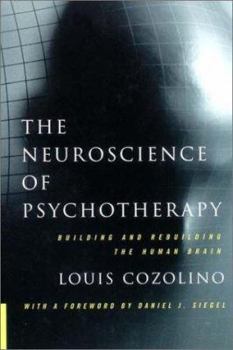The Neuroscience of Psychotherapy: Building and Rebuilding the Human Brain
Select Format
Select Condition 
Book Overview
An update to the classic text that links neuroscience and human behavior in the context of therapy. This groundbreaking book explores the recent revolutionin psychotherapy that has brought an... This description may be from another edition of this product.
Format:Hardcover
Language:English
ISBN:0393703673
ISBN13:9780393703672
Release Date:September 2002
Publisher:W. W. Norton & Company
Length:400 Pages
Weight:1.75 lbs.
Dimensions:1.4" x 6.5" x 9.6"
Customer Reviews
5 ratings
Shows How Cognitive Behavioral Therapy Works
Published by Thriftbooks.com User , 17 years ago
This book is a great source for all cognitive behavioral therapists. One of the main things I got from this book is that we can see how the architecture of the brain is set up for us to manage things from the top down--that is, to manage our emotions from the seat of our cognitive faculties. There are almost 10 times more nerve fibers carrying sensory information from the top down rather than from the bottom up; TO the subcortex FROM the neocortex rather than the other way around. This gives us some idea of the amount of power available to us, once we learn how to access it, to get the cognitive part of our brain to manage the emotional part. The other important part of the book is how our thinking and behavior continue to make physical changes in our brain as long as we live. The book certainly supports the idea of "brainswitching" to the neocortex when the subcortex is agitated with anxiety or depression, which is what all cognitive behavorial therapists try to teach people to do. As the book shows, you can do that by thinking particular thoughts that stimulate neural activity in the part of the brain from which you wish to function. Then, thanks to the neuroplasticity of the brain, if you do this often enough you can actually re-wire your brain to get out of depression and anxiety at will. A. B. Curtiss, author of BRAINSWITCH OUT OF DEPRESSION
An outstanding piece of synthesis. Buy it.
Published by Thriftbooks.com User , 18 years ago
This book is simply a masterpiece in presenting neuroscience relevant to the both researchers in braod areas of psychological science and therapists. The presentation of brain specific information is assured, clear and reasonably well referenced. The book always connects brain regions with manifested behaviours and psychological symptoms. There is so much clarity in the text that it really deserves a very wide audience way beyond what its title suggests. The book embraces aspects of affective and evolutionary neuroscience, ties them to human consciousness development and identifies specific brain developments that cause us to be who we are. The piece of the development of the parietal lobes is one of the best I have ever read. The author has a gift for communication, and this is so rare in neuroscience books that the stands proud of the rest. The tripartite brian, psychology and psycotherapeutic connections are presented with out propagandising one at the expense of the other. There is a degree of good quality speculation in the book from time to time which could set its own research agenda. I will conclude by saying that do give a longer review would runs the risk of spoiling the lively and surprising erudition of the author. Definitely a book worth reading, worth keeping and certainly if you loan it out, you may have trouble getting it back.
Excellent insightful and integrative book
Published by Thriftbooks.com User , 20 years ago
As a psychotherapist opposed to the dominance of the medical model of human problems, yet intrigued by the developments in neuroscience, I welcome this book as an enlighted integration which traces causation in both directions, detailing what Roger Sperry called "top-down" as well as "bottom-up" causation.
Merging Neuroscience and Psychotherapy
Published by Thriftbooks.com User , 21 years ago
Dr. Cozolino has effectively addressed the fragmentation of physiological and psychological approaches to clinical disorders, laying a groundwork for the inevitable meshing of these two broad approaches to dealing with human problems. Increasingly our growing understanding of brain physiology provides opportunities to look for psychological correlates to various brain states. Covering the spectrum of psychological disciplines and relating them to physiological research, he demonstrates cases where a two-pronged therapy makes sense. His book is interspersed with actual case history examples from his practice, and fascinating contemporary neuroscience research. Whereas there is an interesting summary of brain physiology and a broad view of research, the book is clearly written, nicely organized and absorbing in its coverage. Recommended for those who want a view of where treatment of psychopathology is headed, balancing and integrating the psyche and soma.
explains neuroscience and why it matters to you
Published by Thriftbooks.com User , 21 years ago
I've been interested in the many books that have been publishedrecently about consciousness and the brain but until nowI haven't found one that is as comprehensive and well written as this one. The basic neuroscience is explained but the author'sfocus on the relationship of neuroscience to what people experience in therapy, and in their own lives, makes thisbook different than others out there. The book personalizedthe scientific information in such a way that I feel I really learned a lot about how psychotherapy works, and how thebrain works, and the relationship between the two.





